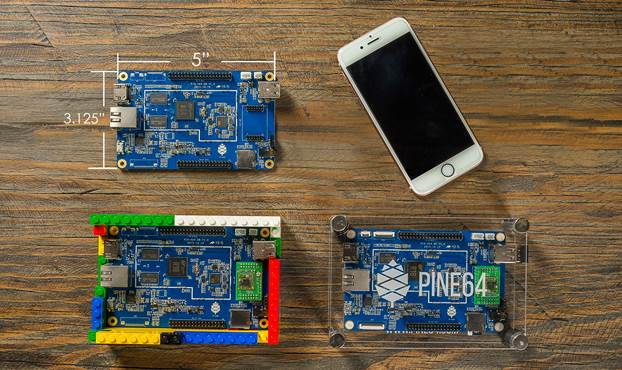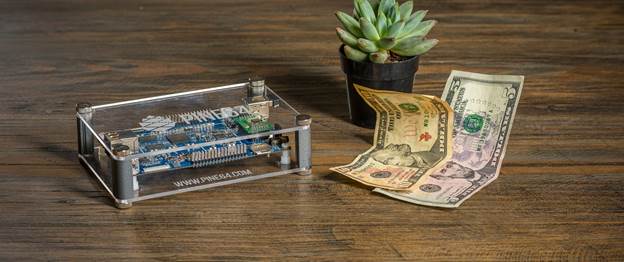Watch Out Raspberry Pi, Here Comes The Pine A64
The Raspberry Pi is about to get a powerful new competitor in the Pine A64. Designed by Pine64, the Pine A64 looks a lot like the Raspberry Pi at a glance, but the similarities between the two systems are only on the surface.
Looks Like Pi
Essentially, the Pine A64 can be viewed as a more powerful next-generation Raspberry Pi device. The Pine A64 contains a quad-core ARM Cortex-A53 CPU clocked at 1.2 GHz. Compared to the Raspberry Pi 2 Model B that was released earlier this year and uses four Cortex-A7 cores clocked at 900 MHz, not only does the Pine A64 have a higher clock speed, but it also has a more advanced architecture, which consumes less power and achieves greater performance.
For graphics processing, the Pine A64 uses the dated Mali-400 MP2 GPU. Although we cannot compare the performance of the GPU inside of the Pine A64 to the VideoCore IV inside of the Raspberry Pi without testing both devices, Pine64 stated that the Pine A64 will be capable of 4K video playback, whereas the Raspberry Pi is limited to a resolution of 1920x1200. This gives the Pine64 an edge and should help to attract users planning to use it as a small HTPC system.
The 64-Bit Issue
As the Raspberry Pi was designed primarily as an educational device for students to learn computer programming, it stands to lose the most in this market. This is because the mobile market is transitioning to 64-bit hardware and software, and 64-bit programming for Android- and ARM-based devices should grow considerably over the next few years. All current Raspberry Pi devices feature 32-bit support and lack the ability to process 64-bit software, preventing students from developing these types of programs.
The Pine A64, on the other hand, uses a 64-bit processor architecture and supports the latest 64-bit version of Android (Lollipop 5.1.1) as well as 64-bit distributions of Linux.
There will be two models, the Pine A64 and the Pine A64+, which differ primarily in the amount of RAM (there’s 512 MB on the A64 and 1 GB on the Pine A64+) and the A64+ has a few extra connections available.
| Pine64 | ||
|---|---|---|
| Model | Pine A64 | Pine A64+ |
| CPU | ARM Cortex-A53 1.2 GHz Quad-Core 64-Bit | ARM Cortex-A53 1.2 GHz Quad-Core 64-Bit |
| GPU | Mali-400 MP2 | Mali-400 MP2 |
| Memory | 512 MB DDR3 | 1 GB DDR3 |
| Storage | MicroSD Up To 256 GB | MicroSD Up To 256 GB |
| Ethernet | 10/100 Mb | 10/100 Mb |
| Wireless | 802.11b/g/n Bluetooth 4.0 (Optional) | 802.11b/g/n Bluetooth 4.0 (Optional) |
| USB | 2 x USB 2.0 | 2 x USB 2.0 |
| Misc. Connections | 3.7V Lithium Battery Charging CircuitHDMI3.5mm Stereo Output mini-jack with Mic Support | 3.7V Lithium Battery Charging CircuitHDMI3.5mm Stereo Output mini-jack with Mic Support5 MP Camera Port4 Lanes MIPI Video PortTouch Panel Port |
| Dimensions (L x W) | 3.125” x 5” | 3.125” x 5” |
| Price | $15 | $19 |
The Pine A64 purports to offer more performance and features than the Raspberry Pi 2 Model B in nearly all areas, but that doesn’t make it a clear winner. As the Raspberry Pi devices have been on the market for some time and have been widely used, they have a significant amount of software support with which the Pine A64 currently can’t compete.
Get Tom's Hardware's best news and in-depth reviews, straight to your inbox.
Depending how you look at it, the Pine A64 may also lose to the Raspberry Pi financially. The two models of the Pine A64 are priced at $15 and $19, respectively, about half the cost of a Raspberry Pi 2 Model B, but the Raspberry Pi Zero costs only $5. The Raspberry Pi Zero also has significantly weaker hardware, a single 32-bit CPU core, so it depends on what you plan to do with the device if the extra $10-$14 is worth investing.
The Pine A64 and Pine A64+ are available for pre-order now via the Kickstarter page.
______________________________________________________________________
Michael Justin Allen Sexton (or MJ) is a Contributing Writer for Tom's Hardware. As a tech enthusiast, MJ enjoys studying and writing about all areas of tech, but specializes in the study of chipsets and microprocessors. In his personal life, MJ spends most of his time gaming, practicing martial arts, studying history, and tinkering with electronics.
Follow Michael Justin Allen Sexton @EmperorSunLao. Follow us on Facebook, Google+, RSS, Twitter and YouTube.
-
kenjitamura You lost me at Kickstarter. Kickstarter campaigns almost always take much longer than their "expect by" dates so I'm guessing by the time this thing hits the market we'll already be really close to a Raspberry Pi 3 release.Reply -
emccalment ReplyYou lost me at Kickstarter.
This means you read the whole article. The author is pleased by this. -
d_kuhn Reading this article was like opening Steam and seeing a cool new game pop up... then going in and watching the trailer and thinking "TAKE MY MONEY"... then seeing that it's a kickstarter and all the trailers were hand animated mockups of what it "might look like".Reply
Kickstarter = "Pay and Pray". Last report I read indicated that 60% never hit funding targets and only 25% of funded projects are successful. Not a good bet... when it's a product let me know - because it sounds cool. -
IInuyasha74 ReplyYou lost me at Kickstarter.
This means you read the whole article. The author is pleased by this.
Haha I have to admit, it does please me to see people read through the article and comment below. It is true that not everything in kickstarter actually comes out, but at the moment, the company hoped to get about $31,000, and has received over $80,000. So the company should have plenty of financial support for now at least. -
Hanin33 The price is nice, but the specs make it a little weak and one of the biggest issues with all of these SBCs is community support, as that seems to be the only way to get anywhere with these things. From what I've had to deal with, none of these platforms seem to have GPU/VPU support in linux yet, so while they will technically work in linux, they don't run very well in it. On the android side, unless there's already a device out with similar hardware, the GPU/VPU issue remains as they often port working ROMs over to these SBCs. On paper, these things seem nice, but there so much work left to do, that these should remain in the domain of your ardent tweaker or EE/CS student.Reply -
d_kuhn Reply17098289 said:From what I've had to deal with, none of these platforms seem to have GPU/VPU support in linux yet, so while they will technically work in linux, they don't run very well in it.
You're right... they're not speed demons if you want to plug a kb/mouse in and run a full gui... but the range of IoT (Internet of Things) apps open to a sub-$10 low power connected device is pretty staggering. I can live with a cmd line os (or more likely a web based remote interface) for that kind of cost/performance. A $15 IoT Camera using this board could blow the 'surveillance camera' market to little chunks of overpriced plastic.
-
IInuyasha74 It isn't really that weak. CPU wise judging by the specs it should be above some mid-range smartphones which still rely on Cortex-A7 processors clocked at around 1 GHz. When you consider the $35 Raspberry Pi, the first one which was a single-core ARM11 700 MHz processor and the newer model which is a quad-core 900 MHz Cortex-A7 quad-core, it is actually relatively fast and should have more than enough performance for web browsing, playing videos, or other basic tasks.Reply -
willy481 "...ReplyThe Pine A64 contains a quad-core ARM Cortex-A53 CPU clocked at 1.2 GHz. Compared to the Raspberry Pi 2 Model B that was released earlier this year and uses four Cortex-A7 cores clocked at 900 MHz, not only does the Pine A64 have a higher clock speed, but it also has a more advanced architecture, which consumes less power and achieves greater performance."
As both use 4 Cortex-A7 cores, the Pi2 900Mhz, the Pine 1.2GHz, can you explain why the Pine is more advanced architecture, and although clocks higher, takes less power ?
Also, acc to other sites, the A64+ has advantage of GBe, but you state both are just FastEthernet.



